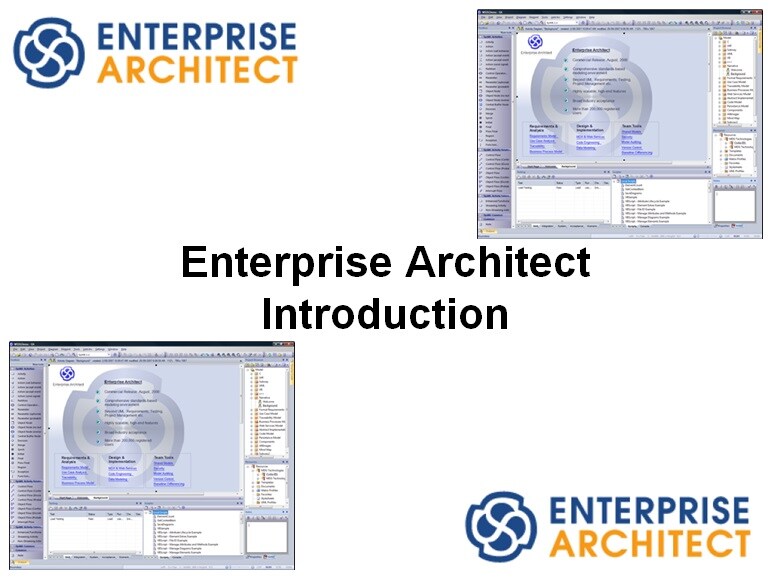-
Learning by doing
-
Trainers with practical experience
-
Classroom training
-
Detailed course material
-
Clear content description
-
Tailormade content possible
-
Training that proceeds
-
Small groups
In the course Sparx Systems Enterprise Architect, participants learn to use the Enterprise Architect tool for system, architecture and business process modeling. The latest and most comprehensive version of Enterprise Architect is used in the course.
The course Sparx Systems Enterprise Architect starts with an overview of the structure of projects with views, models, packages, diagrams, elements and connectors. Also the most important features of Enterprise Architect are discussed such as links versus instances, requirements capturing, documentation generation, reverse engineering, database modeling and support for Model Driven Architecture.
The course follows the development cycle of an application where the requirements are the starting point. Many diagrams in Enterprise Architect are based on the universal modeling language UML. For example, attention is paid to Use Case diagrams that describe the use of a system from an external actor.
Furthermore domain modeling with class and object diagrams and relationships between classes such as association, aggregation, composition and generalization are treated. The static structure of a system is the main focus here. Attention is also paid to the important difference between links and instances in Enterprise Architect. And also discussed is how you can map a model to data base tables with a live database connection.
Then it is time for the treatment of Interaction Modeling with an emphasis on the dynamic aspects of systems. Typical diagrams such as sequence diagrams and collaboration diagram that are the realizations of the Use Cases are discussed here.
Enterprise Architect supports numerous modeling languages for specific applications out of the box. For example the MDG (Model Driven Generation) technologies for Archimate, SysML and SoaML are supported and discussed. Special attention is also paid to Business Process Modeling. It is shown how business processes can be carried out by means of simulations.
Finally attention is paid to how Enterprise Architect provides support for Model Driven Architecture and the associated transformations. The difference between the Platform Independent Model (PIM) and Platform Specific Model and code generations to different languages are discussed.
The course Sparx Systems Enterprise Architect is intended for software engineers, software architects and other future users of Enterprise Architect.
To join the course Sparx Systems Enterprise Architect basic knowledge of UML and object orientation is desirable.
The theory is discussed by means of presentation slides. The concepts are illustrated with demos and there is opportunity to practice. The course material is in English. The course times are from 9.30 up and to 16.30.
Participants receive an official certificate Sparx Systems Enterprise Architect after successful completion of the course.

Module 1 : EA Intro |
Module 2 : Requirements and Use Cases |
Module 3 : Domain Modeling |
| What is Enterprise Architect? UML Modeling Tool of Choice Share Models Capture Requirements Generate Documentation Code Generation Reverse Engineering MDA Transformations Model Databases Link EA to IDE's MDG Technologies |
Understanding Requirements Vision Documents Functional Requirements Non-Functional Requirements Requirements Classification Use Cases and Actors System Context Diagram Identifying Use Cases Scenarios Structuring Use Case Model include and extends |
Conceptual Classes UML Notation and Classes Associations Roles in Associations Multiplicity Generalization and Specialization Aggregation and Composition Attributes Mapping to Databases Live Databases Connections Mapping to XML Schema |
Module 4 : Interaction Diagrams |
Module 5 : MDG Technologies |
Module 6 : MDA Transformations |
| Realizing Requirements From Analysis to Design Object Sequence Diagrams Responsibilities and Methods Class Responsibilities Class Collaborations Interaction Modeling Collaboration Diagrams Translate System Operations Diagram Notations Sequence Diagrams |
MDG Products MDG Technologies Business Process Modeling BPM Simulations Architecture Modeling Archimate Standard Models MDG for Testing SysML SoaML Gang of Four Patterns |
What is MDA? MDA Directions MDA Helicopter View Platform Models Basic Principles of MDA Building MDA Applications Platform Specific Model Marking a Model Model Transformations Generate Implementation Supported Languages |
